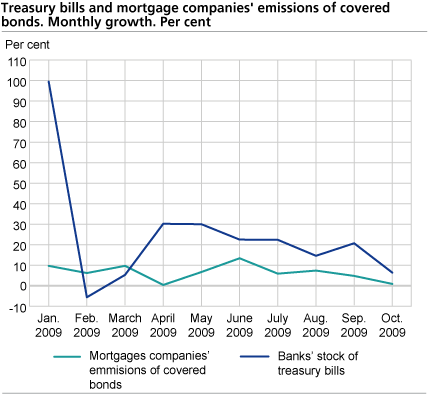Content
Published:
This is an archived release.
Decreasing growth in treasury bills
After several periods of growth in Norwegian banks' stock of Norwegian treasury bills, the growth has decreased considerably during October. This could be related to the announced closure of the "swap arrangement from", where Norwegian banks can exchange covered bonds with treasury bills.
The banks' stock of Norwegian treasury bills amounted to NOK 195 billion by end-October. This is an increase of NOK 11.8 billion, or 6.4 per cent, compared to end-September. The growth has decreased 14.3 percentage points since last month, and is the lowest monthly growth since March this year.
Reduced growth in covered bonds
Norwegian mortgage companies had issued covered bonds for almost NOK 364 billion by end-October. This is an increase of less than 1 per cent since end-September. Since the registration of covered bonds started in December last year, this is the lowest growth during one month except from April.
Norwegian banks' stock of covered bonds amounted to slightly more than NOK 192 billion by end-October, and has also grown by less than 1 per cent during October. As for the mortgage companies, this is the lowest monthly growth except from April.
The previous strong growth in Norwegian banks' stock of treasury bills and mortgage companies’ emission of covered bonds is related to the "swap agreement" between the Norwegian government and the banks, where banks can exchange covered bonds with treasury bills. The Norwegian banks’ stock of treasury bills has increased by more than NOK 192 billion since end-October last year. Because the banks are free to resell the treasury bills they have acquired through this arrangement, the increase in the stock of treasury bills does not fully reflect the total amounts involved in the arrangement.
Closure of new "swap agreements" from December 2009
On 24 October 2008, the Norwegian Parliament gave the Ministry of Finance authority to put into effect an arrangement where Norwegian banks could "swap" covered bonds with treasury bills. This "swap arrangement" was an effort to reduce the negative effects of the financial crisis. The banks can acquire covered bonds either in the market or directly from mortgage companies that are licensed to issue covered bonds. Since the announcement of this offer by the Norwegian government, a number of new mortgage companies have been established. As a result, lending portfolios have been swapped between banks and mortgage companies.
Norges Bank manages the "swap arrangement" and has announced closure of new agreements from December 2009.
|
Mortgage
companies' emission of covered bonds |
Monthly growth.
Per cent |
Banks' stock
of covered bonds |
Monthly growth.
Per cent |
Banks' stock
of treasury bills |
Monthly growth.
Per cent |
||||||||||||||||||||||||||||||||||
|---|---|---|---|---|---|---|---|---|---|---|---|---|---|---|---|---|---|---|---|---|---|---|---|---|---|---|---|---|---|---|---|---|---|---|---|---|---|---|---|
| April 2009 | 250 204 | 0.4 | 117 537 | 0.0 | 67 917 | 30.2 | |||||||||||||||||||||||||||||||||
| May 2009 | 266 869 | 6.7 | 121 207 | 3.1 | 88 312 | 30.0 | |||||||||||||||||||||||||||||||||
| June 2009 | 302 605 | 13.4 | 146 405 | 20.8 | 108 183 | 22.5 | |||||||||||||||||||||||||||||||||
| July 2009 | 320 523 | 5.9 | 165 586 | 13.1 | 132 443 | 22.4 | |||||||||||||||||||||||||||||||||
| August 2009 | 344 142 | 7.4 | 181 491 | 9.6 | 151 764 | 14.6 | |||||||||||||||||||||||||||||||||
| September 2009 | 360 567 | 4.8 | 190 537 | 5.0 | 183 182 | 20.7 | |||||||||||||||||||||||||||||||||
| October 2009 | 363 854 | 0.9 | 192 102 | 0.8 | 194 980 | 6.4 | |||||||||||||||||||||||||||||||||
|
Covered bonds are bonds conferring a preferential claim over a cover pool consisting of public sector loans and loans secured on residential property and other real property. |
The statistics is now published as Banks and mortgage companies.
Contact
-
Statistics Norway's Information Centre
E-mail: informasjon@ssb.no
tel.: (+47) 21 09 46 42

